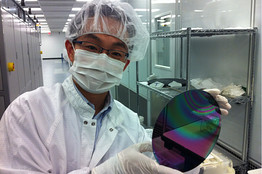The Livermore, Calif., company on Tuesday claimed a breakthrough in using silicon to fabricate light-emitting diodes, the new-wave components that are finding a place in many lighting applications because of their superior energy-efficiency and longevity. A key barrier to their wider use is high cost–$40 price tags aren’t uncommon for 60-watt equivalent bulbs–and that’s where silicon could come in. They have managed to use eight-inch silicon wafers to make components that achieved 135 lumens per watt–essentially reaching commercial-grade performance with the material for the first time. It will take two or three years to improve production yields to make the process commercially viable, but Watkins sees no barriers to using the approach to reduce production costs by 75%. “This is a game-changer around the whole cost structure,” Watkins says. “We think we can get to $5 bulbs.”
Despite their higher efficiencies and longer life, few homes and businesses use LED lighting—largely because of the initial cost. An LED chip makes up 30 to 60 percent of a commercial LED lightbulb. Electronic control circuits and heat management components take up the rest. So for a 60-watt equivalent bulb that costs $40, Bridgelux’s technology could bring the cost down by $9 to $18. Integrating the light chip with the electronics might further reduce costs.
LEDs made with the new technique produce 135 lumens for each watt of power. The U.S. Department of Energy’s Lighting Technology Roadmap calls for an efficiency of 150 lumens per watt by 2012. Some LED makers, such as Cree, in Durham, North Carolina, already sell LED lamps with efficiencies in that range. In contrast, incandescent bulbs emit around 15 lumens per watt, and fluorescent lightbulbs emit 50 to 100 lumens per watt.
It is hard to grow gallium nitride on silicon, mainly because the materials expand and contract at very different rates, explains Colin Humphreys, a materials science researcher at Cambridge University. The process is carried out at temperatures around 1,000 °C, and, upon cooling, the gallium nitride cracks because it is under tension, Humphreys says. One way to solve the problem is to insert additional thin films around the gallium nitride to compress the material and balance out the tension produced during cooling. In fact, Humphreys and his colleagues have used this trick to make gallium-nitride LEDs on silicon; their devices produce 70 lumens per watt. Bridgelux might be using a similar technique. “The result from Bridgelux is impressive,” Humphreys says. “It offers the promise of a large cost reduction without any reduction of efficiency.”
Other LED makers, including Osram, are also trying to make gallium-nitride LEDs on silicon. Bridgelux expects to deliver its first commercial silicon-based LEDs in two to three years
If you liked this article, please give it a quick review on ycombinator or StumbleUpon. Thanks

Brian Wang is a Futurist Thought Leader and a popular Science blogger with 1 million readers per month. His blog Nextbigfuture.com is ranked #1 Science News Blog. It covers many disruptive technology and trends including Space, Robotics, Artificial Intelligence, Medicine, Anti-aging Biotechnology, and Nanotechnology.
Known for identifying cutting edge technologies, he is currently a Co-Founder of a startup and fundraiser for high potential early-stage companies. He is the Head of Research for Allocations for deep technology investments and an Angel Investor at Space Angels.
A frequent speaker at corporations, he has been a TEDx speaker, a Singularity University speaker and guest at numerous interviews for radio and podcasts. He is open to public speaking and advising engagements.



